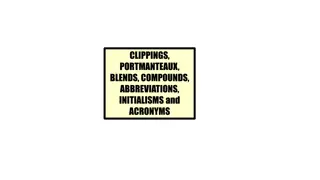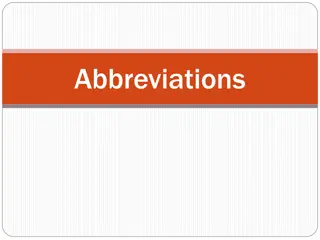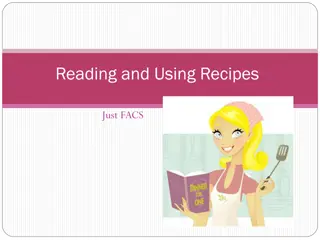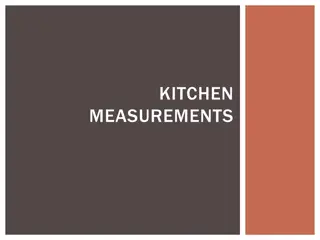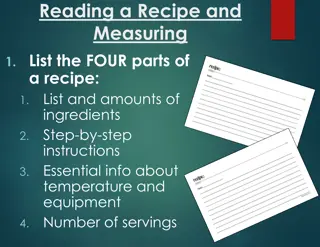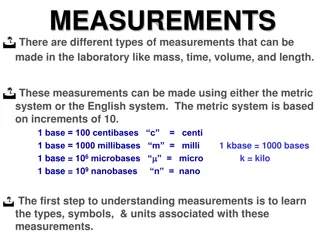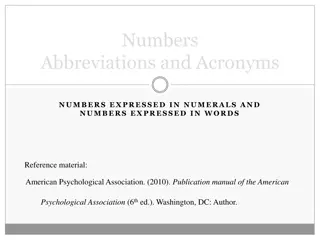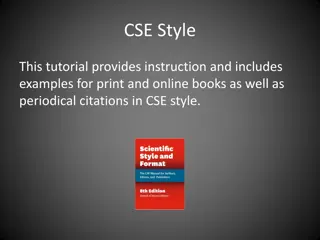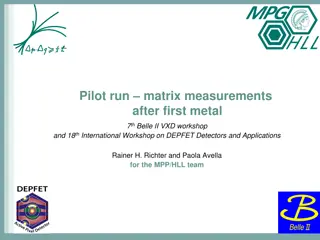Understanding Recipe Language: Abbreviations, Measurements, and Techniques
Recipe language comprises terms that guide how to prepare dishes, including abbreviations, standard measurement equivalents, ingredient amounts, and methods for handling dry and liquid ingredients. Key terms like stir, grate, and knead are essential for a successful cooking experience.
Download Presentation

Please find below an Image/Link to download the presentation.
The content on the website is provided AS IS for your information and personal use only. It may not be sold, licensed, or shared on other websites without obtaining consent from the author. Download presentation by click this link. If you encounter any issues during the download, it is possible that the publisher has removed the file from their server.
E N D
Presentation Transcript
Recipe Language Recipes have a language all their own. This language is made of terms that describe exactly how to prepare, combine, or cook ingredients.
Culinary Language Abbreviation> A shortened form of a word. Example C = Cup Tsp. = teaspoon Tbsp. = tablespoon Measurements Why does the success of recipes depend upon accurate measurements? Success with recipes depends on accurate measurements. If the measurements are off, even the best recipe won t look and taste good? Measurements matters!!
Standard Measurement equivalents 3 teaspoons = 1 tablespoon 16 tablespoons = 1 cup 2 cups = 1 pint 2 pints = 1 quart 4 quarts = 1 gallon 8 fluid ounces = 1 cup 16 ounces = 1 pound Knowing equivalent amounts makes it easy to adjust recipe yields.
Ingredients amounts The amount of each ingredient you need may be given as units, weight, or volumes Units tell you how many of an ingredient you should use. Weights tell you how heavy an ingredients should be (restaurants list ingredients weight because it is easier for chefs to weigh lbs than cups) Volume is the space an ingredients occupies. A cup of flour and a liter of milk are volume measurements
Dry ingredients Dry ingredients are measured using measuring spoons or dry measuring cups Fill the measuring cup or spoon with ingredient Drag the straight edge over the cup or spoon to level off the ingredient Liquid ingredients Liquid ingredients are measured using liquid measuring cups. Small amounts are measured with measuring spoons. Place the liquid measuring cup on a level surface Bend down and look at the measurements written on the side of the measuring cup Be sure to bend down to read measurements if you lift the cup up to check the amount of liquid, the cup will tilt.
Recipe language terms Stir, slice, grate, grind, mince, grease, preheat, sift, baste, drain, scrape, pare, peel, julienne, shred, cube, chop, puree, fold, knead, mix, blend, beat, cream, whip & cut in
Key terms Grease> To rub or spray lightly with fat or oil Puree> To grind or mash food until it becomes smooth and liquid Baste> To moisten foods during baking or roasting with fat, juice, or sauce Knead> To press and fold a ball of dough with the heels of your hands until the dough is smooth and elastic Stir> To Slowly move a spoon in a circle to combine ingredients Fold> To gently combine ingredients. Whip> To beat rapidly with a wire whisk, beater or mixer in order to make a mixture smooth and fully Cream> To beat sugar and a solid fat, such as butter, together until they are smooth and light Cut in> to combine solid fat, such as shortening, with a flour mixture by cutting the fat into tiny pieces with a pastry blender
Key Terms Blend> to mix ingredients until they are very smooth Julienne> To cut into long, thin strips the size of matchsticks Chop> to cut into small, uneven pieces Mince> To cut into very small pieces Sift> To put dry ingredients through a flour sifter or fine sieve Pare> To cut off outer skin with a knife or vegetable peeler


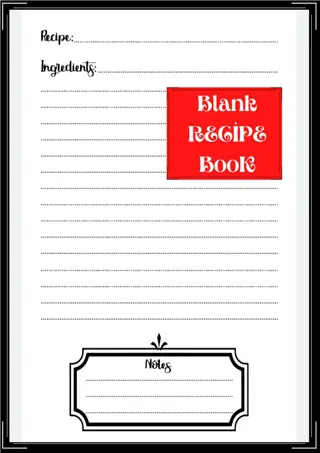
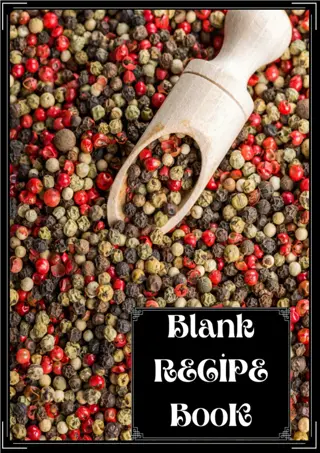
![[✔PDF✔⚡] ✔DOWNLOAD✔ Blank Recipe Book For Holiday Season: My Holiday Recipe](/thumb/68037/pdf-download-blank-recipe-book-for-holiday-season-my-holiday-recipe.jpg)
![GET [✔PDF✔] DOWNLOAD✔ My Vegan Recipe Notebook for all your recipes - 6x9 i](/thumb/68090/get-pdf-download-my-vegan-recipe-notebook-for-all-your-recipes-6x9-i.jpg)

